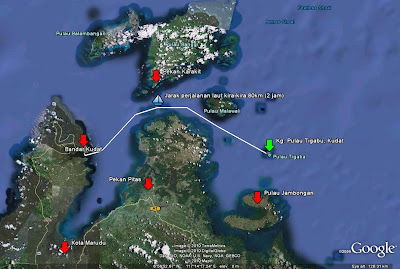Ecosystem Based Management for Fisheries 1
How do you make something quite technical like the Ecosystem Based Management for Fisheries (EBMF) interesting and easy to understand? We tried it by combining it with other more practical and interactive training such as SCUBA Diving.
The Malaysian Non-Governmental Organization (MENGO) group provided some fund for us to develop training material and conduct training to the commercial fishers of the proposed Tun Mustapha Park (TMP). We conducted the combined training on the 10-14 August 2009, with 5 participants from the Persatuan Pemilik Kapal Nelayan Kudat (PPKNK), and 1 participant from the local community. The combined training tried to merge both theories on EBMF at the same time trained them to be divers. We were hoping that through the diving experience the participants were able to understand and appreciate more what is ecosystem.
What is Ecosystem based management? There is a few terms that more or less have similar meaning but with slight differentiation depending on which organization is advocating for them, e.g. Ecosystem Approach (EsA) for Fisheries by FAO, simply EsA for IUCN and EBMF or EBFM for WWF. So many acronyms… can be quite confusing. All in all, for marine ecosystem, it promote sustainable exploitation of resources (e.g. fisheries resources), taking into account the condition of the ecosystems that affect fish stocks and their productivity, as well as the effect of fishing activities on marine ecosystems.
The concept of course is not something new; it has been around for at least 20 years. It seems to be the ‘in-thing’ now as far as environmental management is concern. I supposed it is becoming more popular and gaining recognition after all other management approach seems to fail.
So let’s get to know WWF’s version of EBMF:
The Principle - Ecosystem-based management has objectives and targets that:
1. Focus on maintaining the natural structure and function of ecosystems and their productivity
2. Incorporate human use and values of ecosystems in managing the resource
3. Recognize that ecosystems are dynamic and constantly changing
4. Are based on a shared vision of all stakeholders
5. Are based on scientific knowledge, adapted by continual learning and monitoring
The Implementation Stages: There are 12 steps:
1. Identify stakeholder community.
2. Prepare a map of ecoregions and habitats.
3. Identify partners and their interests or responsibilities.
4. Establish ecosystem values.
5. Determine major factors influencing ecosystem values.
6. Conduct Ecological Risk Assessment (ERA).
7. Establish objectives and targets.
8. Establish strategies for achieving targets.
9. Design information system, including monitoring.
10. Establish research and information needs and priorities.
11. Design performance assessment and review processes.
12. Prepare education and training package for fishers.
Phew, imagine translating and explaining these in Bahasa Malaysia. An ordinary Malay educated person will have difficulties understanding these, what more a mainly Chinese speaking fisherman who can barely understand Bahasa Malaysia. No doubt language is a barrier at the moment. Some things will just get lost in translation; and some technical words just don’t have any translation for it. But we tried our best. So we adapted a game (by TNC) to illustrate the overfishing scenario. We call it the green fish game.
The Green Fish Game illustrating overfishing.
Learning the basics of diving underwater.
Learning the basics of diving on the beach.
End of a successful EBMF and diving training at the Maliangin Sanctuary.
So how do we know it has been successful? We gave a questionaire before and after the training session and before the training 5 of the participants answered wrongly but answered correctly after the training when asked what biodiversity is. It is satisfying to see this change, but I supposed it is not the end of it. We will continue, and see you in the next training session.







Comments
Post a Comment